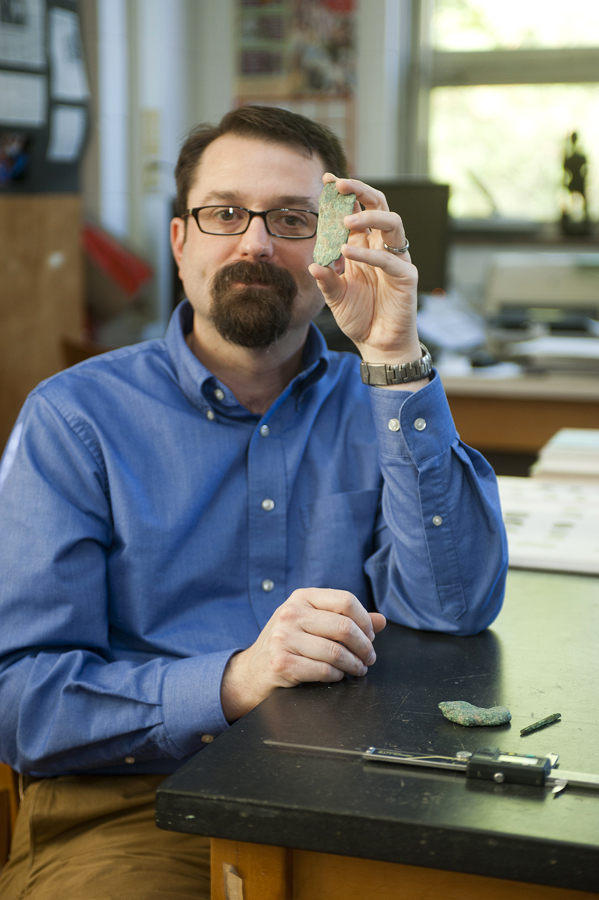Ahtna youth in Alaska learn about historic copper tools, technology in summer program
July 22, 2013
 |
|
H. Kory Cooper, a Purdue assistant professor of anthropology, holds a raw copper nugget from Alaska's Copper River region. In August, Cooper and a graduate student will demonstrate to Ahtna youth from the Copper River region ancient copper working to teach them about the science and art of making copper tools like their ancestors made 1,000 years ago. This programming is supported by a grant Cooper received in 2011 from the Arctic Social Sciences Division of the National Science Foundation, and in partnership with the Ahtna Heritage Foundation. (Purdue University photo/Mark Simons) |
WEST LAFAYETTE, Ind. — Archaeologists with Purdue University will demonstrate ancient copper working at Culture Camps for Alaska native youth in the Copper River Valley in August. The goal is to teach them about the science and art of making copper tools like their ancestors made 1,000 years ago.
"The Ahtna culture is rich in stories and history about their ancestors and copper, and our program will bring in the science components of archaeology, geology and engineering of native copper," said H. Kory Cooper, an assistant professor of anthropology, who has been working in the Copper River Region since 1995. Cooper focuses on archaeometallurgy, which is the study of ancient and historic metals.
"After learning about the science of copper and archaeology, the campers will have a chance to make tools using traditional Ahtna copper-working techniques and native copper nuggets," he said. "By incorporating archaeology and science lessons with their cultural history, we hope to inspire these youth to study science or engineering."
Copper found in a very pure form, considered 99.99 percent and is known as native copper, was used by several different native groups in Alaska and Yukon as early as about 1,000 years ago. The Ahtna, a Dene-speaking Alaska native group, were best known for their copper-working skills and for their control of the trade of copper to other native groups.
Children from the Ahtna communities of Klutina and Ts'edi'na will participate in the cultural day camps, which are sponsored by the Ahtna Heritage Foundation and run by community members. The program dates are Aug. 2 and 3 for the Klutina community, which is near the city of Copper Center, and Aug. 10 for the Ts'edi'na community, which is about 50 miles from Copper Center. This programming is supported by a grant Cooper received in 2011 from the Arctic Social Sciences Division of the National Science Foundation. Several Ahtna communities offer culture camps on a regular basis, usually in the summer, where youth can learn more about their culture and traditional technology including such topics as gathering, preparing and preserving different foods, tanning hides, and hunting and fishing.
Purdue graduate student Elizabeth Carroll, who is working on her master's degree in anthropology and studies metal work, will lead the cultural camp students through using stone tools and traditional Ahtna techniques to make tools out of native copper nuggets.
"We want to let the youth feel and work with the material and experience how long it takes to create something," Cooper said.
The tools will be mirrored after items found at a local archaeological site near the Ahtna community of Gulkana that was excavated by Cooper and others in the 1990s. These tools, which include awls, date back to A.D. 900-1200. An awl is an all-purpose tool used to punch holes in leather for sewing and a variety of other tasks.
Cooper also will share with the students his research on native copper innovation in the region, how this technology emerged in the past, how it was used, and how it spread.
As part of the National Science Foundation grant, Cooper also is examining pieces from various museum and regional collections to catalog locations of finds and to answer questions about technology development, trade routes and past social and political processes.
Additionally, Cooper is collaborating with the Ahtna Heritage Foundation, which is the nonprofit Native Alaskan organization responsible for education and cultural programs in the Copper River region, on the creation of a book and exhibit about the native copper for the Cultural Center in Copper Center, Alaska.
Other collaborators on this project include the Ahtna Heritage Foundation; University of Alaska Museum of the North at the University of Alaska-Fairbanks; Antonio Simonetti, research associate professor at the University of Notre Dame; Bill Simeone, cultural anthropologist; and Robert "Jeff" Speakman, associate director of the University of Georgia's Center for Applied Isotope Studies.
Cooper also has a courtesy appointment in Purdue's School of Materials Engineering, where, in collaboration with Carol Handwerker, Purdue's Reinhardt Schuhmann Jr. Professor of Materials Engineering, he has developed a course titled "Archaeology and Materials Science." Graduate and undergraduate students in the course learn some of the methods and theories used to study ancient technology.
Writer: Amy Patterson Neubert, 765-494-9723, apatterson@purdue.edu
Source: H. Kory Cooper, hkcooper@purdue.edu
Related news release: NSF grant will shine light on ancient copper artifacts, innovation in Alaska

